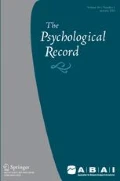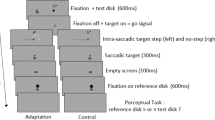Abstract
Experiments with pigeons have suggested that the way stimuli are arranged in tests affects the demonstration of the stimulus control established during training. The present study aimed to replicate these findings with humans exposed to a simultaneous-discrimination task with compound stimuli. Adults were exposed to a discrimination task, and their eye fixations were recorded. Two compound stimuli were used: a triangle and a red circle, and a square and a green circle. During Phase 1, responses to the first compound were reinforced, and during Phase 2, these contingencies were reversed. Following training in each phase, the components of the stimulus compound were separated and presented across different tests to assess stimulus control by each stimulus component. Participants tended to choose the component on which their eyes had most frequently fixated during training. However, the S+ component that was associated with fewer fixations also controlled participants’ choices. Results on tests replicate previous findings with pigeons. Possible effects of peripheral vision are discussed.




Similar content being viewed by others
Notes
The notation S+ and S- hereafter will be used in reference to the programmed contingency. Thus, even if a programmed S+ component does not control responses during tests, it will be referred to as an S+ component.
References
Birkimer, J. C. (1969). Control of responding by the elements of a compound discriminative stimulus and by the elements as individual discriminative stimuli. Journal of the Experimental Analysis of Behavior, 12, 431–436.
Born, D. G., & Peterson, J. L. (1969). Stimulus control acquired by components of two color-form compound stimuli. Journal of the Experimental Analysis of Behavior, 12, 437–442.
Dube, W. V., & Hiris, J. (1999). Match to sample program (Version 11.6.7) [Computer software]. Walthan, MA: E. K. Shriver Center of Mental Retardation.
Dube, W. V., Lombard, K. M., Farren, K. M., Flusser, D. S., Balsamo, L. M., & Fowler, T. R. (1999). Eye tracking assessment of stimulus overselectivity in individuals with mental retardation. Experimental Analysis of Human Behavior Bulletin, 17, 8–14.
Dube, W. V., Lombard, K. M., Farren, K. M., Flusser, D. S., Balsamo, L. M., Fowler, T. R., & Tomanari, G. Y. (2003). Stimulus overselectivity and observing behavior in individuals with mental retardation. In S. Soraci & K. Murata-Soraci (Eds.), Visual information processing (pp. 109–123). London: Proeger.
Dube, W. V., Balsamo, L. M., Fowler, T. R., Dickson, C. A., Lombard, K. M., & Tomanari, G. Y. (2006). Observing behavior topography in delayed matching to multiple samples. The Psychological Record, 56, 233–244.
Dube, W. V., Dickson, C. A., Balsamo, L. M., O’Donnell, K. L., Tomanari, G. Y., Farren, K. M., . . . McIlvane, W. J. (2010). Observing behavior and atypically restricted stimulus control. Journal of the Experimental Analysis of Behavior, 94, 297–313.
Farthing, G. W., & Hearst, E. (1970). Attention in the pigeon: testing with compounds of elements. Learning and Motivation, 1, 65–78.
Goulart, P. R. K., Mendonça, M. B., Barros, R. S., Galvão, O. F., & McIlvane, W. J. (2005). A note on select- and reject-controlling relations in the simple discrimination of capuchin monkeys (Cebus apella). Behavioural Processes, 69, 295–302.
Johnson, D. F., & Cumming, W. W. (1968). Some determiners of attention. Journal of the Experimental Analysis of Behavior, 11, 157–166.
Johnson, C., & Sidman, M. (1993). Conditional discrimination and equivalence relations: control by negative stimuli. Journal of the Experimental Analysis of Behavior, 59, 333–347.
Kendall, S. B., & Mills, W. A. (1979). Attention in the pigeon: testing for excitatory and inhibitory control by the weak elements. Journal of the Experimental Analysis of Behavior, 31, 421–431.
Magnusson, A. (2002). Topography of eye movements under select and reject control. Unpublished doctoral dissertation, Northeastern University, Boston.
Perez, W. F. (2008). Movimentos dos olhos e topografias de controle de estímulos em treino de discriminação condicional e testes de equivalência (Master’s thesis, Programa de Pós-graduação Psicologia Experimental, Universidade de São Paulo, São Paulo). Retrieved from http://www.teses.usp.br.
Pessôa, C., Huziwara, E., Perez, W. F., Endemann, P., & Tomanari, G. Y. (2009). Eye fixations to figures in a four-choice situation with luminance balanced areas: Evaluating practice effects. Journal of Eye Movement Research, 2(5), 3, 1–6. Retrieved from http://www.jemr.org/online/2/5/3.
Reynolds, G. S. (1961). Attention in the pigeon. Journal of the Experimental Analysis of Behavior, 4, 203–208.
Reynolds, G. S., & Limpo, A. J. (1969). Attention and generalization during a conditional discrimination. Journal of the Experimental Analysis of Behavior, 12, 911–916.
Saunders, R. R., Saunders, K. J., Kirby, K. C., & Spradlin, J. E. (1988). The merger and development of equivalence classes by unreinforced conditional selection of comparison stimuli. Journal of the Experimental Analysis of Behavior, 50, 145–162.
Schroeder, S. R. (1969). Effects of cue factors on selective eye movements and choices during successive discriminations. Perceptual and Motor Skills, 29, 991–998.
Schroeder, S. R. (1970). Selective eye movements to simultaneously presented stimuli during discrimination. Perception & Psychophysics, 7, 121–124.
Schroeder, S. R. (1997). Selective eye fixations during transfer of discriminative stimulus control. In D. M. Baer & E. M. Pinkston (Eds.), Environment and behavior (pp. 97–110). Boulder: Westview.
Skinner, B. F. (1953). Science and human behavior. New York: The Free Press.
Stromer, R., & Osborne, J. G. (1982). Control by adolescent’s arbitrary matching-to-sample by positive and negative stimulus relations. Journal of the Experimental Analysis of Behavior, 37, 329–348.
Wilkie, D. M., & Masson, M. E. (1976). Attention in the pigeon: a re-evalation. Journal of the Experimental Analysis of Behavior, 26, 207–212.
Author’s note
During the preparation of the manuscript, the authors were supported by the following grants: William Ferreira Perez by FAPESP (doctoral fellowship, Grant # 2011/19125-2), Peter Endemann by CNPq (doctoral fellowship, Grant # 140636/2009-9), Candido V. B. B. Pessôa by FAPESP (post-doc fellowship, Grant # 2011/19125-2), and Gerson Y. Tomanari by CNPq. Data collection and preparation of the manuscript were supported by CNPq (Grant # 573972/2008-7) and FAPESP (Grant # 08/57705-8), both at the Instituto Nacional de Ciência e Tecnologia sobre Comportamento, Cognição e Ensino (INCT-ECCE), coordinated by Dr. Deisy G. de Souza (UFSCar).
We are grateful to Saulo Velasco, Erik Arntzen, the editor and an anonymous reviewer for helpful comments on early versions of the manuscript.
Author information
Authors and Affiliations
Corresponding author
Rights and permissions
About this article
Cite this article
Perez, W.F., Endemann, P., Pessôa, C.V.B.B. et al. Assessing Stimulus Control in a Discrimination Task with Compound Stimuli: Evaluating Testing Procedures and Tracking Eye Fixations. Psychol Rec 65, 83–88 (2015). https://doi.org/10.1007/s40732-014-0092-1
Published:
Issue Date:
DOI: https://doi.org/10.1007/s40732-014-0092-1




